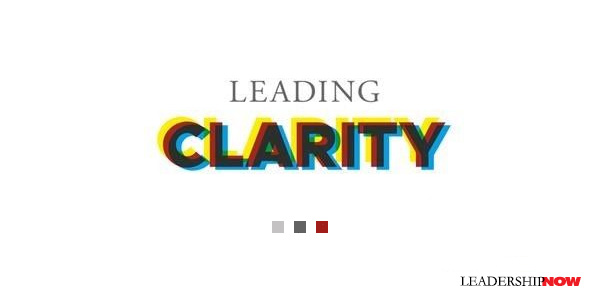 |
 |
05.04.18

Leading Clarity
T In Leading Clarity, Brad Deutser states that “Clarity operates on the truth that everything is connected.” Clarity connects. “Clarity is the foundational fabric that weaves together dreams, goals, initiatives, concerns, challenges, and triumphs.” Clarity not only defines an organization, but it also protects and stabilizes it too. Considered as a destination, clarity can be lost or obscured the moment the landscape changes, or the environmental factors dim your view. In clarity, we can see all the factors, recognize them for what they are and what they can become, and create connections that can be relied on to establish or reestablish equilibrium and an environment for growth. This distinction matters to us because especially in times of great change and emerging opportunities, we can easily lose our way—our focus. Businesses fail—people fail—due to a lack of clarity. When disruptions come it is easy to move out of clarity. “Clarity become central to your ability to not only visualize, but actualize your performance.” Clarity should transcend your environment. When we are in clarity, we can maintain a constant flow of energy and maintain connections. Deutser identifies 12 circuit breakers that disconnect us from clarity: fear, ambivalence, clutter, labeling, doubt, impatience, boredom, conflict, overconfidence, physical depletion, inference or shallowness, and resources. This comment was interesting regarding our need to tolerate ambiguity: Being in clarity allows space where we wait for what we don’t quite understand to emerge, which keeps energy available and flowing rather than being boxed in, covered up, or mistakenly shelved through what’s already known. Too often we miss lessons, opportunities, and shifts in thinking, because we want to quickly fill the space of not knowing. Clarity needs structure and has to be created. So how do create this state of clarity? Deutser begins by working inside-the-box. We all work within constraints or within our particular box—a box of our own making. So we start by understanding our box. From there we can grow and/or change our box. When working in the box, your playing field is more defined and there is greater understanding of specifics and their possible impact on your desired outcome. There is also more empathy and connectivity in the box because there is definition. … The box provides a form of clarity for all to grab hold of and work toward. The powerful point is that the box is of your own making. You should also understand that while the sides of the box exist, they can be permeable, to let things flow in and out, and be flexible, to expand and contract when deemed necessary; but, once inside, each element serves to interact with the whole.
Direction: What are our values? Where are we headed? Is leadership aligned with values? Operations: Do we adapt well to change? What are our metrics? Do our systems and processes ensure high-quality work? People: Do we develop our team? Do we give timely and consistent feedback? Are we highly collaborative? Engagement: Coaching and Development, Talent Management, and Team Capabilities Organizational Identity: Who are we? Why do we exist? What motivates us? This side—your identity—is the foundations of everything you do. It is the foundation from which you can build the space for your thinking to exist in. Environmental Factors: What external factors affect or shape who we are? What do competitors do that we would never identify with or do ourselves? This framework helps you to understand who you are, where you are going, and how you work. As individuals and organizations we all have constraints. So it’s really what’s in the box that drives performance. Working within the box provides the context where innovation is likely and more importantly, implementable. When you understand the box it is easier to work and be productive within it. The box gives intentionality to everything you do. There’s no such thing as perfect, but “there is such a thing as being whole, which signifies the big picture as it weaves al the smaller pieces together. Being whole in this respect denotes a sense of closure that comes after all the parts fit together. Striving to be in clarity is about the process of becoming whole, of intentionally incorporating all the important aspects of your business into one connected form that accounts for the outside world as well.” It is the magic of your own ability to control [the construction of your box] that both protects and nourishes and becomes that which withstands and even thrives in chaos, change, and uncertainty. If you think of the sides of that box as being permeable rather than fixed, it frees the flow of input information in and the release of old ways and toxic byproducts out and away from your core. You build your own box. So what is your box and what do you need it to be? 
Posted by Michael McKinney at 06:41 AM
|
BUILD YOUR KNOWLEDGE
 

How to Do Your Start-Up Right STRAIGHT TALK FOR START-UPS 
Grow Your Leadership Skills NEW AND UPCOMING LEADERSHIP BOOKS 
Leadership Minute BITE-SIZE CONCEPTS YOU CAN CHEW ON 
Classic Leadership Books BOOKS TO READ BEFORE YOU LEAD |